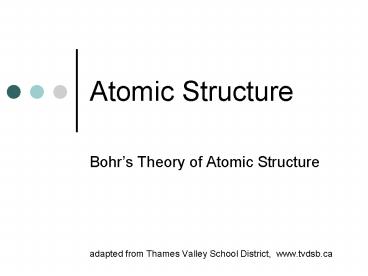Atomic Structure - PowerPoint PPT Presentation
1 / 17
Title:
Atomic Structure
Description:
Atomic Structure Bohr s Theory of Atomic Structure adapted from Thames Valley School District, www.tvdsb.ca Neils Bohr (1885 1962) Neils Bohr came to the ... – PowerPoint PPT presentation
Number of Views:92
Avg rating:3.0/5.0
Title: Atomic Structure
1
Atomic Structure
- Bohrs Theory of Atomic Structure
- adapted from Thames Valley School District,
www.tvdsb.ca
2
Neils Bohr (1885 1962)
- Neils Bohr came to the Cavendish laboratory,
headed by Ernest Rutherford. - He also investigated the structure of the atom,
but instead of using radiation, he used gas
discharge tubes.
3
Neils Bohr (1885 1962)
- Bohr was interested in spectral lines emitted by
atoms. - Bunsen and Kirchhoff developed the technique of
spectroscopy in 1859. - When white light passes through a prism, it
splits into component colors. - Red light lowest energy
- Violet light highest energy
4
Dispersion of White Light
Different wavelengths of light are bent at
different angles when they enter and leave the
glass. This separates the different wavelengths,
making them visible to the naked eye.
5
Dispersion of White Light
The wavelengths of light with a shorter
wavelength (higher frequency) are bent
(refracted) at a greater angle than the longer
wavelengths.
6
Neils Bohr (1885 1962)
- If light from an element in a gas discharge tube
is passed through a prism, a unique set of
colored lines are observed, called emission or
bright line spectra. - The lines observed are unique to the element,
like a fingerprint.
7
Neils Bohr (1885 1962)
Gas discharge tube where photons are emitted
Slit
Figure 1. Setup for observing bright line
spectrum.
Prism
8
Neils Bohr (1885 1962)
Figure 2 Emission spectra for Hydrogen, Mercury
and Neon
9
Neils Bohr (1885 1962)
- Bohr sought an explanation for these unique
spectral lines. - He used Max Pläncks idea that energy is
quantized. - He suggested that if light comes in discrete
quanta, then perhaps electrons are also only
allowed certain energy levels.
10
Neils Bohr (1885 1962)
- This allowed Bohr to explain the spectral lines
as the energy emitted by electrons when they move
from a high energy level to a lower one. - The electron would have to emit a quantum of
energy in the form of light equal to the change
in energy level. - This would be observed as spectral lines.
11
Neils Bohr (1885 1962)
An atom in its ground state. Its electron
encounters a quantum of energy.
The electron transitions to a higher energy
level. The atom is now in an excited state.
The electron returns to a lower energy level and
emits a photon of energy equal to the transition
of the electron.
12
Neils Bohr (1885 1962)
- Bohr concluded that
- The orbits of electrons are stationary levels.
Electrons do not emit energy in this ground
state. - Electrons can only gain or lose certain amounts
of energy, called quanta, making a transition to
an excited state, or higher level.
13
Neils Bohr (1885 1962)
- When photons collide with electrons, they provide
the energy to make a transition, or quantum leap. - When electrons fall back to their original ground
state, they emit a photon of energy equal to the
energy required to make the transition. - This results in the observed spectral lines.
14
Neils Bohr (1885 1962)
Figure 4. Electrons emit photons of energy equal
to the energy of the transition between orbits
(stationary states).
15
The bright line spectra lines seen for hydrogen
are not the only lines produced. Lines in the
infrared and ultraviolet part of the
electromagnetic spectrum are also produced.
16
Neils Bohr (1885 1962)
- Although Bohr described electrons as orbits,
physically that is not what is meant orbits
are a symbol for the energy states of electrons. - We should as such draw Bohr diagrams as energy
levels, not orbits.
17
Neils Bohr (1885 1962)
- Flash animation of Bohr model and emission of
light - http//www.upscale.utoronto.ca/PVB/Harrison/BohrMo
del/Flash/BohrModel.html































